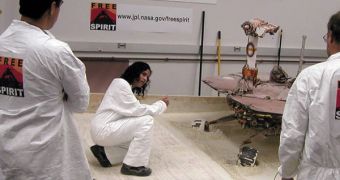In the specially designed sandbox at the Jet Propulsion Laboratory (JPL), in Pasadena, California, Mars Exploration Rovers engineers are looking at all possible rover movement options, in order to determine the most appropriate sequence of getting Spirit out of Troy. Yesterday, the experts analyzed if modifying the sequence in which the exploration robot's wheels moved for it to turn had any influence on the efforts to release it from its sandy trap. These “building block” maneuvers are very important, as they constitute the basis of Spirit's handling abilities on Mars.
The backwards-driving, five-year-old rover has been trapped in a patch of loose soil called Troy on the Martian surface since May 6th. Its wheels are covered up to their hubcaps in sand, and the terrain has a 12-degree inclination.
To make matters worse, pictures that Spirit took of its underside revealed a rock that threatened to touch its belly, essentially immobilizing it for good. JPL engineers now have to devise a series of maneuvers using the rover replica in their lab, so that all wheels are unjammed and contact with the rock is completely avoided.
Free Spirit reports that turns in place or crablike slant moves could be combined in order to get the desired effect. In their reconstruction of Troy, the experts attempted to recreate the soil composition and inclination as accurately as possible, based on the many images that the rover took of its surroundings since it got trapped. Data from the two orbiters NASA has in position around Mars is also being used in the overall picture.
Thus far, attempts to move the test rover have only yielded moderate results. The replica managed to shift its position by just half an inch, after spinning its wheels long enough to cover several tens of meters on rougher terrain. Rigorous measurements are being conducted after each maneuver, so as to assess its exact effects. All these data will be taken into account, as the complexity of the actions the team will try to take increases.
Currently located in a feature known as the “Home Plate,” Spirit has driven about 122 meters (400 feet) from its winterly location to its current position. The last development in its situation is but the last problem in a long row, which has seen the observation robot experiencing bouts of amnesia. Its flash memory was damaged, most likely by a solar emission, which has forced its computers to repeatedly restart over the past few months. That situation is resolved now, and the rover is experiencing surges in its power levels, thanks to the wind's action. On the other side of Mars, Opportunity is doing just fine.

 14 DAY TRIAL //
14 DAY TRIAL //